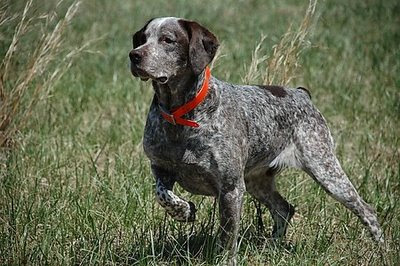The Braque du Bourbonnais (Bourbonnais Pointing Dog) was already known in 1598 (“Natural History”, Aldovrandi National Library). The ancient authors described him as a pleasant companion of the hunter, of hardy and healthy appearance. His white coat is entirely covered with fine brown or fawn ticking. The Braque du Bourbonnais (Bourbonnais Pointing Dog) breeders of the 1930’s wanted to impose a “faded lilac” coloured coat along with the obligation of being born with a naturally short tail. This strict selection put the existence of the breed in danger. In the 1970’s, a team of breeders decided to work for the survival of the Bourbonnais Pointing Dog. The present state of the breed allows us to be confident about the future of the breed.
Braque du Bourbonnais
Braque du Bourbonnais Breeders
Braque du Bourbonnais Breed Standard
Braque du Bourbonnais is medium sized, short-haired “Braque” type (“braccoid”), medium proportions tending towards brachymorphic type, of robust build, compact and muscular. He gives the impression of strength and power, without excluding a certain elegance. The silhouette of the female is less stocky and more elegant. Height at the withers: Dogs: 51 – 57 cm, Bitches: 48 – 55 cm
Tolerance of +/- 1cm.
Braque du Bourbonnais temperament in the home he is kind and affectionate. When hunting, his passion and intelligence allow him to easily adapt to the most varied terrains and game. When searching, he naturally carries the head high to find the scent, proving his aptitude for useful and precise pointing. The essential breed characteristic is the so-called “pear” shape. Neither too fine nor too heavy, it is well proportioned to the body.
Skull: Round, seen from all sides. The lateral sides are rounded, the parietal bones and zygomatic arches well developed. The axes of the skull and the muzzle are parallel, or very slightly divergent towards the front. Stop: Moderately defined.
Facial Region
Nose: Broad, with well opened nostrils. It sometimes protrudes over the perpendicular line of the lips. Its colour matches that of the coat, without unpigmented patches. Muzzle: Strong and broad at its base, tapering slightly towards the tip to form a truncated cone. Not as broad in females. Bridge of the nose: Straight or slightly convex. Lips: Not too thick, the upper lip covers the lower lip without forming too much of a fold at the corners of the mouth; the edges of the lips are well pigmented.Jaws/teeth: Strong and of equal length, with complete dentition, forming a scissor bite. A level bite is tolerated. Eyes: Large, more or less rounded, hazel or dark amber depending on the colour of the coat. The look is expressive, kind and intelligent. The eyerims are well pigmented. Ears: Of medium length, they can either reach or extend beyond the throat. Their base, rather broad, is attached at eye level or slightly above, which is appreciated. They hang naturally against the cheeks, flat or slightly curled inwards.
Body
Topline: Straight and well sustained. The withers are well defined. Back: Solid and well muscled. Loin: Short, broad and muscled; well coupled to the back. Slightly longer in females. Croup: Rounded, moderately oblique, with powerful muscles. Chest: Wide, long and deep, reaching or extending slightly below the level of the elbow. The sternum reaches as far back as possible. Ribs well sprung. Underline: Progressively rising. The flank is flat and only slightly raised.
Tail
Some dogs are born naturally without a tail. If this is not the case, the tail should be docked at its base. It is set rather low. In countries where docking is illegal, the long tail should be carried below the topline when the dog is standing.Coat
HAIR: Fine, dense and short; a little coarser, and sometimes longer, on the back. On the head and ears, the hair must be finer and shorter. COLOUR: The white patching is very invasive, with fine brown ticking (formerly called “wine dregs”) or fawn flecking (formerly called “peach blossom”) and all variants. The ear is generally the same colour as the ground colour and more or less ticked. An intimate mix of white and coloured hairs, giving an overall roan colour, is also accepted. On the head, as for the body, coloured patches are only accepted in small numbers and sizes.
Faults
Any departure from the foregoing points should be considered a fault and the seriousness with which the fault should be regarded should be in exact proportion to its degree and its effect upon the health and welfare of the dog.


















Hello,
ReplyDeleteHere is the detailled history of the breed, including its recreation in the 70's:
History of the braque du Bourbonnais